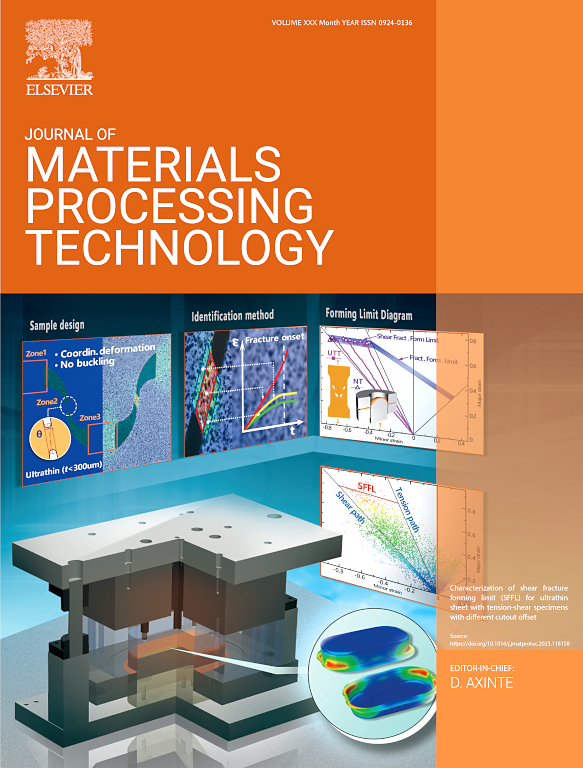窄间隙环芯可调激光焊接钛合金的显微组织和力学性能:熔池形貌的观察
IF 6.7
2区 材料科学
Q1 ENGINEERING, INDUSTRIAL
Journal of Materials Processing Technology
Pub Date : 2025-06-11
DOI:10.1016/j.jmatprotec.2025.118934
引用次数: 0
摘要
环芯可调激光焊接由于其弥合间隙、调节微观结构和提高焊缝机械性能的能力而越来越被人们所接受。然而,窄间隙结构熔池形态的起源以及影响显微组织和力学性能的全厚度非均质性的机制尚不清楚。为了解决这一需求,本文报道了一项结合实验和计算的研究,研究了窄间隙结构环芯可调激光焊接(NGR-CALW)中坡口间隙和环芯比对熔池形貌的影响。通过数值流场模拟,深入分析了不同坡口间隙和环芯比下熔池流动行为和温度梯度分布,阐明了焊缝形貌和显微组织特征的演化机理。结果表明,坡口间隙的增大使焊缝截面形状由窄深转变为宽浅。此外,环芯比的增加显著扩大了有效的侧壁熔化面积,导致更圆润和更饱满的上部焊缝轮廓。熔池形态的多样性源于不同的散热动力学和冷却梯度,从而导致了凹形、平形和凸形熔池在空间上的异质微观结构。优化槽隙和环芯比匹配的NGR-CALW有利于22 mm厚TC4钛合金的快速凝固和细化凝固组织的发展。该研究为理解窄间隙结构钛合金的NGR-CALW现象提供了一个视角,为窄间隙激光焊接工艺的优化奠定了基础。本文章由计算机程序翻译,如有差异,请以英文原文为准。
Enhanced microstructure and mechanical properties in narrow gap ring-core adjustable laser welding of titanium alloys: Insights from molten pool morphology
Ring-core adjustable laser welding is gaining increasing acceptance due to its ability to bridge gaps, modulate microstructure, and enhance the mechanical properties of welds. However, the origins of molten pool morphology in narrow gap structure and mechanisms affecting through-thickness heterogeneity in microstructure and mechanical properties is not well understood. To address this need, here we report a combined experimental and computational study to investigate the effects of groove gap and ring-core ratio on molten pool morphology in ring-core adjustable laser welding with a narrow gap structure (NGR-CALW). The molten pool flow behavior and temperature gradient distribution under varying groove gaps and ring-core ratios were thoroughly analyzed through numerical flow field simulations, elucidating the evolution mechanisms of weld morphology and microstructural characteristics. The results demonstrate that an increased groove gap enables a transition in the weld cross-sectional shape from narrow and deep to wide and shallow. Moreover, an increase in the ring-core ratio significantly widens the effective sidewall melting area, resulting in a more rounded and fuller upper weld profile. The morphological diversity of molten pool stems from differential heat dissipation dynamics and cooling gradients, consequently inducing spatially heterogeneous microstructures between concave-shaped, flat-shaped and convex-shaped molten pools. Finally, NGR-CALW with optimizing groove gap and ring-core ratio matching was found to favor rapid solidification and the development of finer solidification microstructure in joining 22 mm thick TC4 titanium alloys. This study may provide a perspective in understanding the phenomena involved in the NGR-CALW of titanium alloys with a narrow gap structure and lay the foundation for optimization of the narrow gap laser welding process.
求助全文
通过发布文献求助,成功后即可免费获取论文全文。
去求助
来源期刊

Journal of Materials Processing Technology
工程技术-材料科学:综合
CiteScore
12.60
自引率
4.80%
发文量
403
审稿时长
29 days
期刊介绍:
The Journal of Materials Processing Technology covers the processing techniques used in manufacturing components from metals and other materials. The journal aims to publish full research papers of original, significant and rigorous work and so to contribute to increased production efficiency and improved component performance.
Areas of interest to the journal include:
• Casting, forming and machining
• Additive processing and joining technologies
• The evolution of material properties under the specific conditions met in manufacturing processes
• Surface engineering when it relates specifically to a manufacturing process
• Design and behavior of equipment and tools.
 求助内容:
求助内容: 应助结果提醒方式:
应助结果提醒方式:


